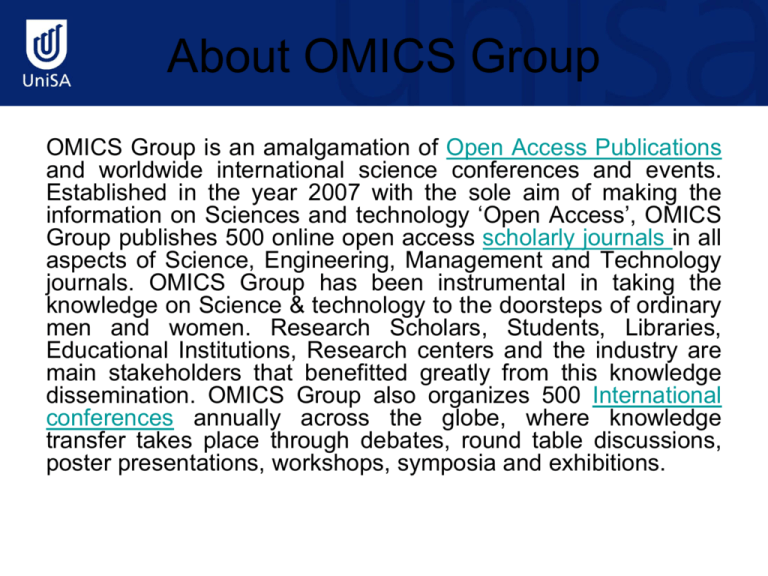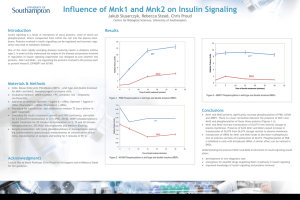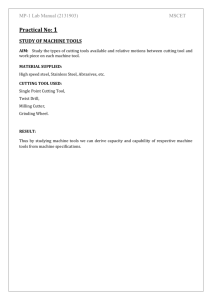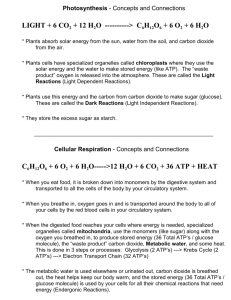Prostate cancer cells
advertisement

About OMICS Group OMICS Group is an amalgamation of Open Access Publications and worldwide international science conferences and events. Established in the year 2007 with the sole aim of making the information on Sciences and technology ‘Open Access’, OMICS Group publishes 500 online open access scholarly journals in all aspects of Science, Engineering, Management and Technology journals. OMICS Group has been instrumental in taking the knowledge on Science & technology to the doorsteps of ordinary men and women. Research Scholars, Students, Libraries, Educational Institutions, Research centers and the industry are main stakeholders that benefitted greatly from this knowledge dissemination. OMICS Group also organizes 500 International conferences annually across the globe, where knowledge transfer takes place through debates, round table discussions, poster presentations, workshops, symposia and exhibitions. OMICS International Conferences OMICS International is a pioneer and leading science event organizer, which publishes around 500 open access journals and conducts over 500 Medical, Clinical, Engineering, Life Sciences, Pharma scientific conferences all over the globe annually with the support of more than 1000 scientific associations and 30,000 editorial board members and 3.5 million followers to its credit. OMICS Group has organized 500 conferences, workshops and national symposiums across the major cities including San Francisco, Las Vegas, San Antonio, Omaha, Orlando, Raleigh, Santa Clara, Chicago, Philadelphia, Baltimore, United Kingdom, Valencia, Dubai, Beijing, Hyderabad, Bengaluru and Mumbai. Towards pharmacological validation of MNKs as anti-cancer drug targets Dr Hugo Albrecht School of Pharmacy and Medical Sciences University of South Australia Kinases as Cancer Drug Targets “Hard Targets” KO leads to strong or lethal phenotype (e.g. PLK1) Adverse effects are expected. Use of advanced formulation to target cancer cells (e.g. nanoparticles, liposomes etc.) “Soft Targets” KO with no obvious or mild phenotype (e.g. Mnk1/2) 4 http://www.cellsignal.com/ref erence/kinase/overview.html Anti-cancer strategy •Targeting cancer cells through block of several pathways Cancer Cell R-point Mitosis Cell cycle Translation Transcription 5 Targeting Translation: Mnk1/2 Growth Factors SOS PTEN PDK1 Stress Integrins FAK Src Grb2 Ras PI3K mut Akt TSC1/2 S6K1 mTOR Cancer S6Ks Rheb Raf MEKK Mek1/2 MKK3/6 Erk1/2 P38a/b 4E-BP eIF4E Translation Phosphorylation of eIF4E by Mnks Erk1/2, p38 4E _P Mnk 1/2 4 A m7G AUG 3 40S 7 AAAAA Ccl2, Ccl7, MMP-3, MMP-9, Mcl1, Bcl2, Myc, PDGF, FGF2, VEGF, IL-1B, IL-15, TNF-a Adapted from Hay N., 2010, PNAS, Vol.107, No. 32, 13975-13976 and Pyronnet, S.; Imataka, H.; Gingras, A. C.; Fukunaga, R.; Hunter, T.; Sonenberg, N. The EMBO journal 1999, 18, 270 Elevated eIF-4E phosphorylation promotes tumorigenesis Diab, S.; Kumarasiri, M.; Yu, M.; Teo, T. H. S.; Milne, R.; Proud, C.; Wang, S. Chem. Biol. 2014, 21, 441 Graff, J. R.; Konicek, B. W.; Carter, J. H.; Marcusson, E. G. Cancer research 2008, 68, 631. 8 Rationale • eIF4E is frequently overexpressed in cancers and is associated with cellular transformation, tumorigenesis and metastatic progression. • In Mnk1/2 DKO mice: -eIF4E phosphorylation is completely abolished -Cells are resistant to transformation by Ras and tumour formation is significantly delayed in PTEN-/- x Mnk DKO mice lymphoma model2) • Knock-in mice with a eIF4E S209A mutation are resistant to: -Oncogene induced transformation1) -PTEN loss-induced prostate cancer1) • Normal growth of Mnk DKO and eIF4E S209A KI mice. 9 Mnk1 and Mnk2 inhibitors may be effective and non-toxic anticancer drugs References: 1. Luc Furic et al PNAS 2010, 107 (32), 14134-14139 /.2. Takeshi Ueda et al PNAS 2010, 107 (32), 13894-139908 Aim: Design and characterization of Mnk1/2 inhibitors Compound library Default active site detected by FRED receptor program as shown in the blue box Primary assay Quick, robust and cost effective IMAP Primary hits Default active site created by FRED receptor program Mnk1 Dual Mnk2 Competition effect 3D structure of staurosporinebound Mnk2-KR obtained from the Protein Databank (PDB: 2HW7) ATP - + + - eIF4E peptide - - + + Cytotoxicity 10 Secondary assay Dose response and competition assay ADP-Glo Migration/ Metastasis Mnk structure Primary compound profiling with IMAP assays IMAP: Immobilised Metal Ion Affinity Particle Progressive Binding System high TR-FRET PO4 IMAP binding reagent Tb Mnk sensitizer ATP PO4 fluorescent peptide substrate phosphopeptide Tb-donor linker M nk1 100ng MIII 125 % A c t iv it y ( 1 0 M ) % A c t iv it y ( 1 0 M ) PO4 M nk2 30ng 125 100 75 50 25 0 100 75 50 25 0 0 11 MIII 25 50 75 % A c t iv it y 1 M 100 125 0 25 50 75 % A c t iv it y 1 M 100 125 Mnk eIF4E202-214 Kinase detection reagent ADP-Glo reagent L u m in e s c e n c e (R L U ) 1 0 0 0 ADP-Glo Assay Luciferase + Light ADP/ATP mix ATP ADP Beetle luciferin ATP AMP 10 9 IC 5 0 M n k 2 3000 2000 M nk1 M nk2 1000 0 0 1 L u m in e s c e n c e (R L U ) 5 4 3 2 1 M nk1 2500 M nk2 2000 L u m in e s c e n c e (R L U ) 1000 1000 6 1500 1000 500 1 2 M nk2 600 300 0 0 .0 0 .2 0 .4 0 .6 0 .8 1 .0 0 1 2 3 4 5 6 A T P c o n c (m M ) N K N I- K 4 I- M nk1 900 M M -6 1 7 4 M N K M I- N 5 K IK N -1 I- 5 8 8 0 2 IK N M M 5 M N K I- 7 -5 0 -2 2 I- K IN N M M K K I- 2 -3 2 5 -2 2 IN M M N K N M K I- 1 7 7 3 6 3 N M N K K I- I- 8 9 8 1 M N M M N K K I- 5 IK M N N M I- 7 5 7 IK I- 6 K IN N K M 1200 A T P c o n c (m M ) 0 0 M 4 IC 5 0 M n k 1 7 IC 5 0 ( M ) 3 e IF 4 E 202-214 c o n c ( m M ) 8 12 2 7 dual inhibitors 13 Mnk2 specific (Mnk1 > 10x Mnk2) Mnk1/2 Crystal Structure Discrepancy Crystal structure of Mnk1 (PDB entry 2HW6) 13 Crystal structure of Mnk2 (PDB entry 2AC3) Identification of Type I/II Mnk inhibitors S D 4 -6 1 , M n k 2 3 0 n g 120 50 M A TP % K in a s e A c t iv ity eIF4E fixed at 600 µM (KM) 100 200 M A TP 80 400 M A TP 800 M A TP 60 1200 M A TP 40 2000 M A TP 20 0 -4 -3 -2 -1 0 1 2 L o g S D 4 -6 1 ( M ) S D 4 -6 1 , M n k 2 3 0 n g 120 1 5 0 M e IF 4 E % K in a s e A c t iv ity ATP fixed at 200 µM (KM) 100 6 0 0 M e IF 4 E MNKI-4-61 1 2 0 0 M e IF 4 E 80 1 8 0 0 M e IF 4 E 60 2 4 0 0 M e IF 4 E 40 3 0 0 0 M e IF 4 E 20 0 -4 -3 -2 -1 0 1 2 L o g S D 4 -6 1 ( M ) 14 Data Mean ± SEM, n=2 Identification of Type I/II Mnk inhibitors S D 5 -1 7 , M n k 2 3 0 n g eIF4E fixed at 600 µM (KM) 120 % K in a s e A c t iv it y 50 M A TP 100 200 M A TP 80 400 M A TP 800 M A TP 60 1200 M A TP 40 2000 M A TP 20 0 -4 -3 -2 -1 0 1 2 L o g S D 5 -1 7 ( M ) S D 5 -1 7 , M n k 2 3 0 n g ATP fixed at 200 µM (KM) 120 % K in a s e A c t iv ity 1 5 0 M e IF 4 E 100 6 0 0 M e IF 4 E MNKI-5-17 1 2 0 0 M e IF 4 E 80 1 8 0 0 M e IF 4 E 60 2 4 0 0 M e IF 4 E 40 3 0 0 0 M e IF 4 E 20 0 15 -4 -3 -2 -1 0 L o g S D 5 -1 7 ( M ) 1 2 Data Mean ± SEM, n=2 Identification of Type III Mnk inhibitors eIF4E fixed at 600 µM (Km) T A G -6 , M n k 2 3 0 n g 120 50 M A TP % K in a s e A c t iv ity 100 200 M A TP 80 400 M A TP 60 800 M A TP 1200 M A TP 40 2000 M A TP 20 0 -4 -3 -2 -1 0 1 2 L o g T A G -6 ( M ) T A G -6 , M n k 2 3 0 n g ATP fixed at 200 µM (Km) 120 % K in a s e A c t iv ity 1 5 0 M e IF 4 E 100 MNKI-6 6 0 0 M e IF 4 E 80 1 2 0 0 M e IF 4 E 60 1 8 0 0 M e IF 4 E 2 4 0 0 M e IF 4 E 40 3 0 0 0 M e IF 4 E 20 0 -4 16 -3 -2 -1 0 L o g T A G -6 ( M ) 1 2 Data Mean ± SEM, n=2 Type I/II vs. Type III inhibitors 120 120 ATP Concentration 80 50 M 60 200 M 2000 M 40 < 6 fold 20 0 ATP Concentration 100 % K in a s e A c t iv it y % K in a s e A c t iv it y 100 50 M 80 200 M 60 2000 M 40 20 0 -3 -2 -1 0 1 2 L o g T A G -1 5 ( M ) -3 -2 -1 1 2 L o g T A G -5 ( M ) MNKI-5 MNKI-15 DFD in with MNKI-15 17 0 DFD in with MNKI-5 100 100 80 80 GI50 MV4-11 GI50 MV4-11 MV4-11 Leukemia cells 60 40 r = 0.4006 p = 0.0780 40 20 20 0 0 0 18 r = 0.7276 p = 0.0005 60 2 4 IC50 Mnk1 6 8 0 1 IC50 Mnk2 2 Summary Compound library 66 compounds IMAP Summary inhibition No 35 31 No ADP-Glo IC50 < 2 µM Yes 11 20 10 µM < 10% or 1 µM < 75% Mnk1 0 Dual Mnk2 7 13 Competition effect ATP - + + - - + + - eIF4E peptide - - + + - - + + Compounds 8 4 1 0 1 5 1 0 CDK2/9 Ki > 15 µM 8 3 1 0 1 4 0 0 MV4-11 cytotoxicity 19 6 0 0 1 1 GI50 < 10 µM P-Akt + + Androgen dependent + - Metastatic - + PC-3A8 - PC-0 - MV4-11 PTEN MNKI-7 83 44 35 0.83 >10 8.65 MNKI-19 279 136 135 7.30 >10 >10 MNKI-67 1400 36 X 8.84 >10 >10 Mnk2 PC-3A8 Mnk1 PC-0 eIF4E WB Prostate cancer cells IC50 (nM) 20 GI50 (µM) Prostate cancer cells 21 Conclusions Potent Mnk1/2 and selective Mnk2 inhibitors have been identified. Detailed kinetic studies revealed three types of binding modes. Our studies confirm different structural properties of Mnk1 and Mnk2 at the ATP-binding pocket. But they share a common allosteric binding site. Mnk inhibitors are cytotoxic against some leukemia cells. No cytotoxicity has been observed against prostate cancer cells. Mnk inhibitors blocked LPS induced migration of prostate cancer cells. 22 Acknowledgement Prof Shudong Wang Dr Matt Sykes A/Prof Bob Milne Dr Tom Peat Chemistry Sarah Diab Dr Mingfeng Yu Yuchao Yang Todd Alexander Gillam 23 Biology Raffaella Schmid Theodosia Teo Dr Peng Li Dr Frankie Lam Ben Noll Tracy Lu COMMONWEALTH OF AUSTRALIA Copyright Regulations 1969 WARNING This material has been produced and communicated to you by or on behalf of the University of South Australia pursuant to Part VB of the Copyright Act 1968 (the Act). The material in this communication may be subject to copyright under the Act. Any further reproduction or communication of this material by you may be the subject of copyright protection under the Act. Do not remove this notice. 24 Major Heading Here Subheading when required 25 Let us meet again.. We welcome you all to our future conferences of OMICS International 4th Annual Conference on European Pharma Congress June 18-20,2016, Berlin, Germany. http://europe.pharmaceuticalconferences.com/






